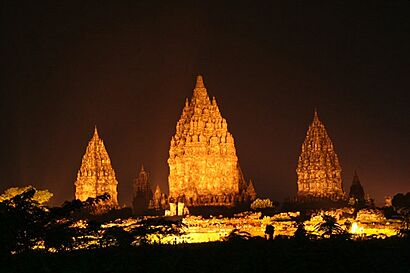Sanjaya dynasty facts for kids

The Sanjaya dynasty was a powerful family that ruled the Mataram Kingdom on the island of Java, Indonesia, a long time ago. This was during the first thousand years CE. The Sanjaya rulers were important because they helped spread Hinduism across Java.
Contents
How the Sanjaya Dynasty Began
The Sanjaya dynasty started in 732 CE. We know this from an old stone carving called the Canggal inscription. This inscription was found in a village called Canggal. It tells us that Sanjaya of Mataram founded the dynasty.
The Canggal inscription was written in an old Indian script. It talks about setting up a special stone symbol of the Hindu god Shiva on a hill. This hill was in an area called Kunjarakunja on an island named Yawadwipa, which is now known as Java. The inscription says Java had lots of rice and gold.
Before Sanjaya, a wise king named King Sanna ruled Yawadwipa. His rule was peaceful and good. But after King Sanna died, the kingdom became messy and confused. That's when Sanjaya, who was King Sanna's nephew (son of his sister Sannaha), became king. Sanjaya was very smart and skilled in fighting. He took control of nearby areas. His leadership brought peace and wealth back to the kingdom.
Another old text, called Carita Parahyangan, also talks about Sanjaya. It says Sanjaya was the son of King Sanna and Sannaha. This text also mentions that King Sanna was defeated by his cousin, King Purbasora. Sanjaya later got his kingdom back. He ruled over large parts of Java, including West Java, Central Java, and East Java, and even Bali. He also fought against other kingdoms like Malayu and Kalingga Kingdoms. Most of what Carita Parahyangan says matches the Canggal inscription.
Sanjaya and Shailendra Dynasties
For a long time, historians wondered how the Sanjaya dynasty was connected to another important dynasty called the Shailendra dynasty.
One idea was that the Sanjaya and Shailendra families were actually part of the same ruling family. They both ruled the Mataram Kingdom in central Java. This theory suggests that Sanjaya and his family were part of the Shailendra family, and they were originally followers of Shiva (Shaivist).
Another idea is that the Shailendra dynasty became very powerful around 778 CE. They might have pushed the Sanjaya dynasty to rule only in northern Java for a while. However, some evidence suggests that both dynasties lived side-by-side in central Java peacefully.
The Shailendra family later became followers of Mahayana Buddhism. This happened after one of their kings, Raja Sankhara, converted to Buddhism. Later Shailendra kings also supported Buddhism in Java. But then, starting with King Rakai Pikatan, the Sanjaya dynasty brought back the focus on Hinduism.
Some historians believe the Shailendras came from Sumatra and were connected to the powerful Srivijaya empire. They might have taken control of central Java and included the Sanjaya kings in their government. Their main court was likely in the southern Kedu Plain, near Magelang.
Rulers of Central Java
A very important event happened when the Sanjaya crown prince, Rakai Pikatan, married Pramodhawardhani. She was the daughter of the Shailendra king Samaratungga. This marriage helped the Hindu Sanjaya influence grow stronger than the Buddhist Shailendra in Mataram.
Rakai Pikatan eventually defeated King Balaputra, who was Pramodhawardhani's brother. By 850 CE, the Sanjaya dynasty became the only rulers in Mataram. Balaputra then went to rule in Srivijaya, Sumatra.
We have more information about the Sanjaya kings from the Balitung inscription from 907 CE. This inscription helped historians figure out the order of the Sanjaya kings:
- Sanjaya (732–760 CE)
- Panangkaran (760–780 CE)
- Panungalan (780–800 CE)
- Samaragrawira (Rakai Warak) (800–819 CE)
- Rakai Garung (819–838 CE)
- Rakai Pikatan (838–850 CE)
- Rakai Kayuwangi (850–898 CE), also known as Lokapala
- Balitung (898–910 CE)
During the Sanjaya dynasty, classic Javanese stories and literature became very popular. Old Hindu stories like the Kakawin Ramayana were translated into Old Javanese. Around the 850s, King Pikatan started building the famous Prambanan temple in central Java. King Balitung later finished and expanded it. The Prambanan temple complex is one of the biggest Hindu temple complexes in Southeast Asia. It is as grand as Borobudur, which is the world's largest Buddhist temple.
After King Balitung, these Sanjaya kings ruled:
- Daksa (910–919 CE)
- Tulodong (919–924 CE)
- Wawa (924–929 CE)
- Mpu Sindok (929–947 CE)
End of the Sanjaya Dynasty
In 929 CE, King Mpu Sindok moved the Mataram kingdom's capital from central Java to eastern Java. We don't know exactly why this happened. It might have been because of a volcano eruption from Mount Merapi, or perhaps a power struggle, or even pressure from the Shailendra dynasty in the Srivijaya Empire.
This move to eastern Java marked the end of the Sanjaya dynasty's rule in central Java. After them, the Isyana dynasty took over.
See also
- Candi of Indonesia
- List of monarchs of Java

